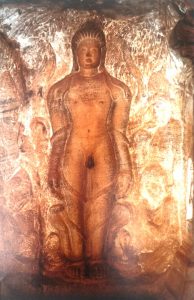Badami Cave
The Badami Jaina cave, situated at the top-most end of four rock-cut shrines of which the first three are Hindu, is by its location, interior embellishment and layout a jewel of a sacred retreat.
Noticeable at first sight, the warm, reddish-brown hue of the grained sandstone bestows upon the lovingly carved statues of Bahubali and his two sisters at one end of the outer mandapa (hall), as well as upon the equally impressive Parshvanatha on the opposite side, a pleasing life-like appearance.
A seated Mahavira presides in the inner cell. Adinatha, the first Tirthankara, flanked by twenty standing and four seated Jinas demonstrates from the humdrum of the world. The dividing pillars, the remaining walls and the ceilings of the outer and inner mandapa, have all been subjected to the creative vision of the cave’s builder and his sculptors.
To work a rock which was not of the usually monotonous grey must have inspired them into giving the best of their skill.
Three Hindu caves are situated some flights of steps down the vertical cliff, in which Shiva wields his weapons of war and in which Vishnu is represented as a fierce fighter against all sorts of danger (J.C.Harle, the above mentioned author.
Badami, Jaina Cave. Bahubali flanked by his sisters and worshipped by two attendants. Carved in the 7th century. it is one of the earliest sculptures representing Bahubali.
Carved in the 7th century. it is one of the earliest sculptures representing Bahubali.
denotes the figurative sculptures in these temples as ‘self-assertive, almost brutal.) Unlike these caves, dedicated to Shiva and Vishnu, this somewhat removed Jaina cave-temple emits a aura of serenity and self-reliance. For the Jaina, the first step towards subduing evil is not the handing out of weapons for every available hand but
 Badami. Jaina Cave: Parshvanatha with protective snakehoods over his head and adored by Padmavati (holding the umbrella). At his left foot his Yaksha (demigod) Dharanendra.
Badami. Jaina Cave: Parshvanatha with protective snakehoods over his head and adored by Padmavati (holding the umbrella). At his left foot his Yaksha (demigod) Dharanendra.
the presence of a steadfast and fearless mind. If it was a message the builders of this cave-temple wanted to convey to the pilgrims, it would be the assurance, as taught by the Jinas, that the powers of the mind are superior to the use of physical strength.
